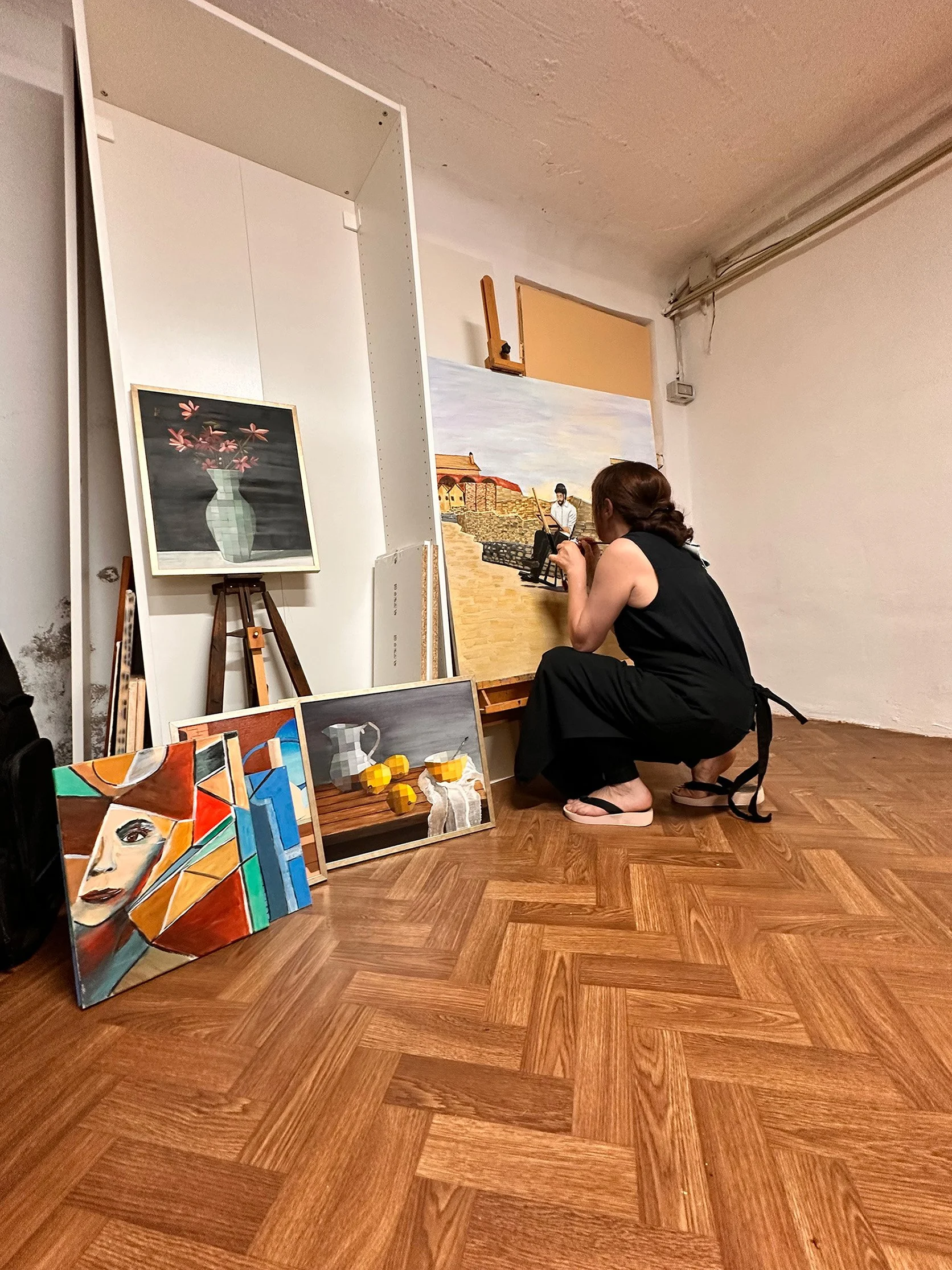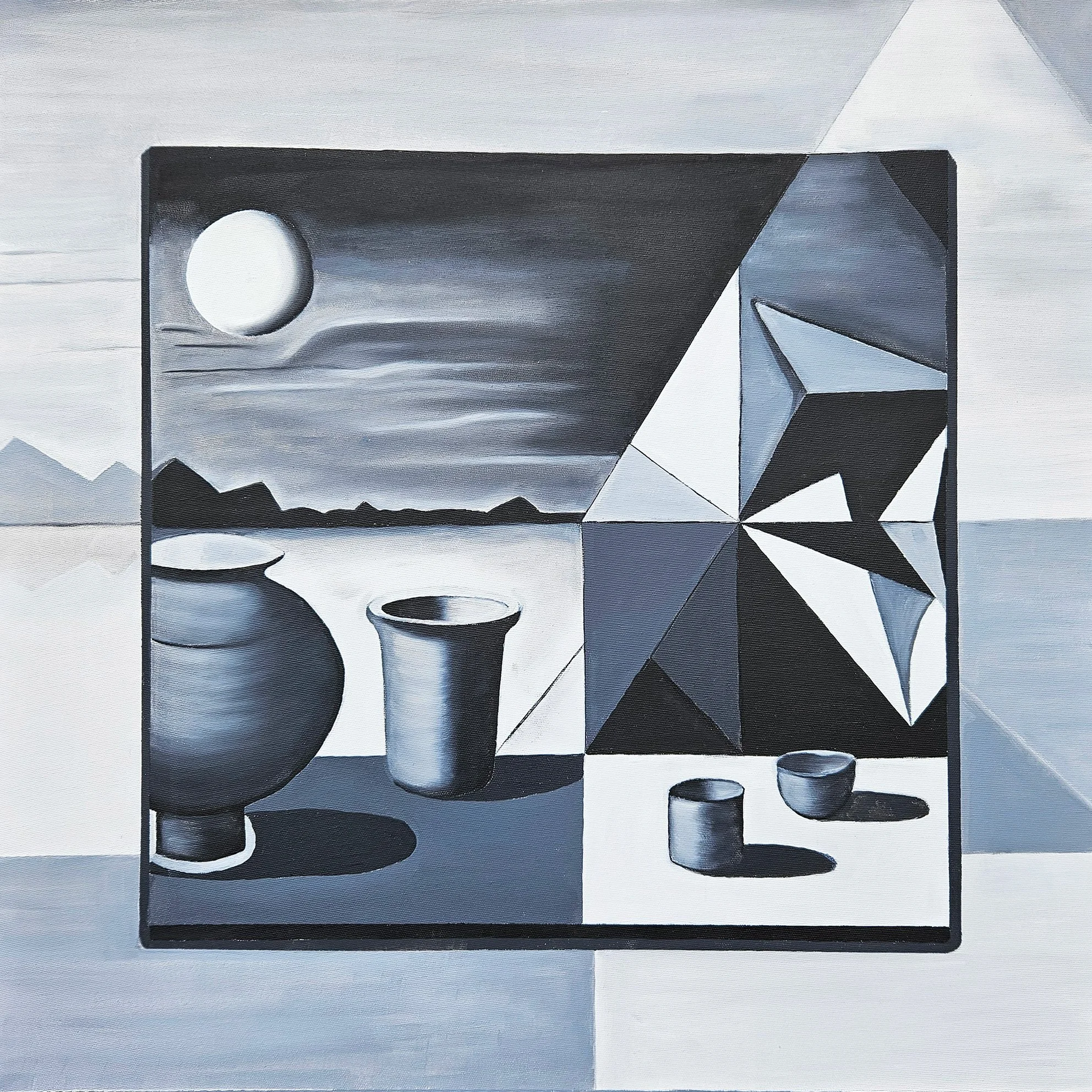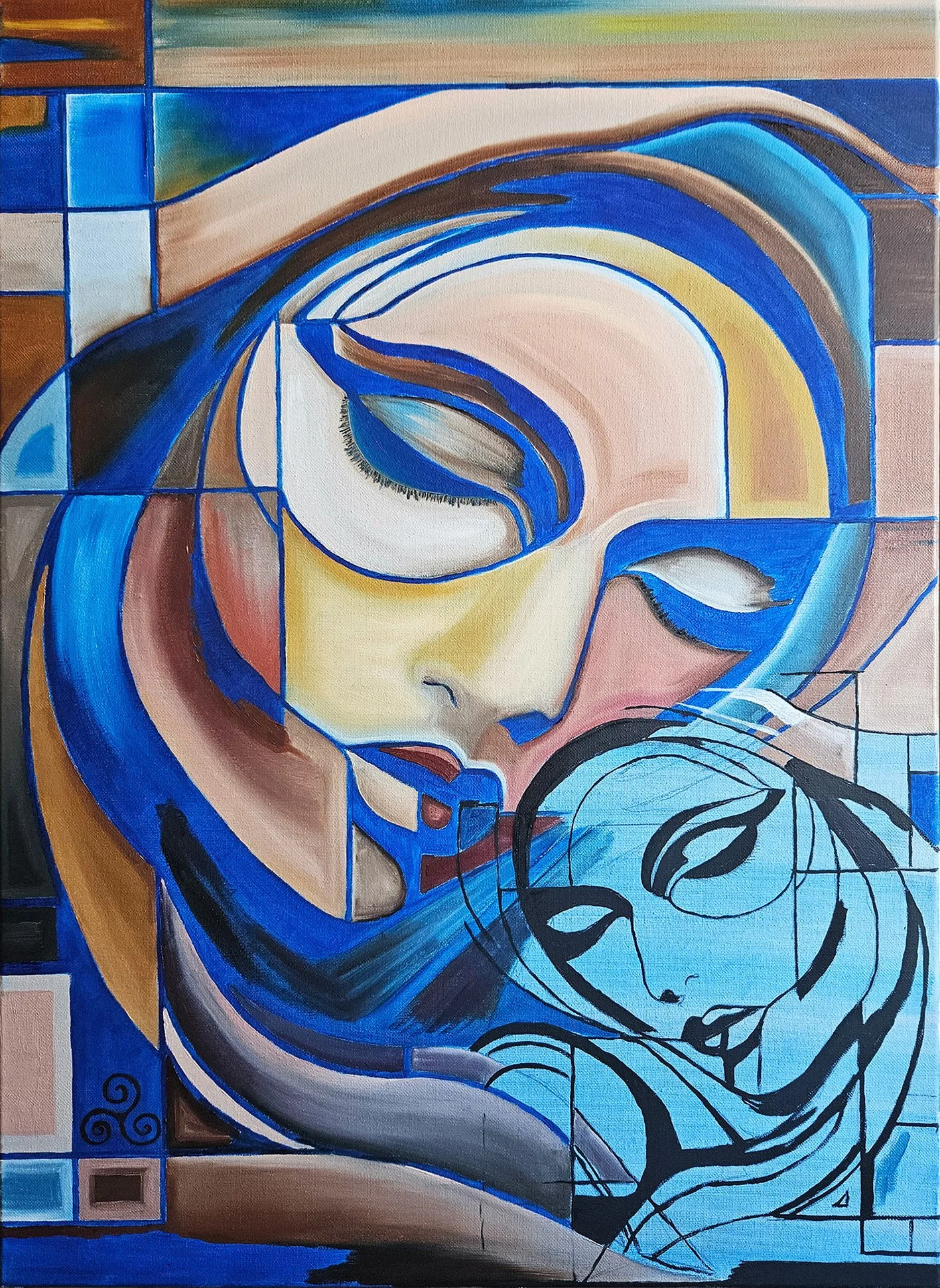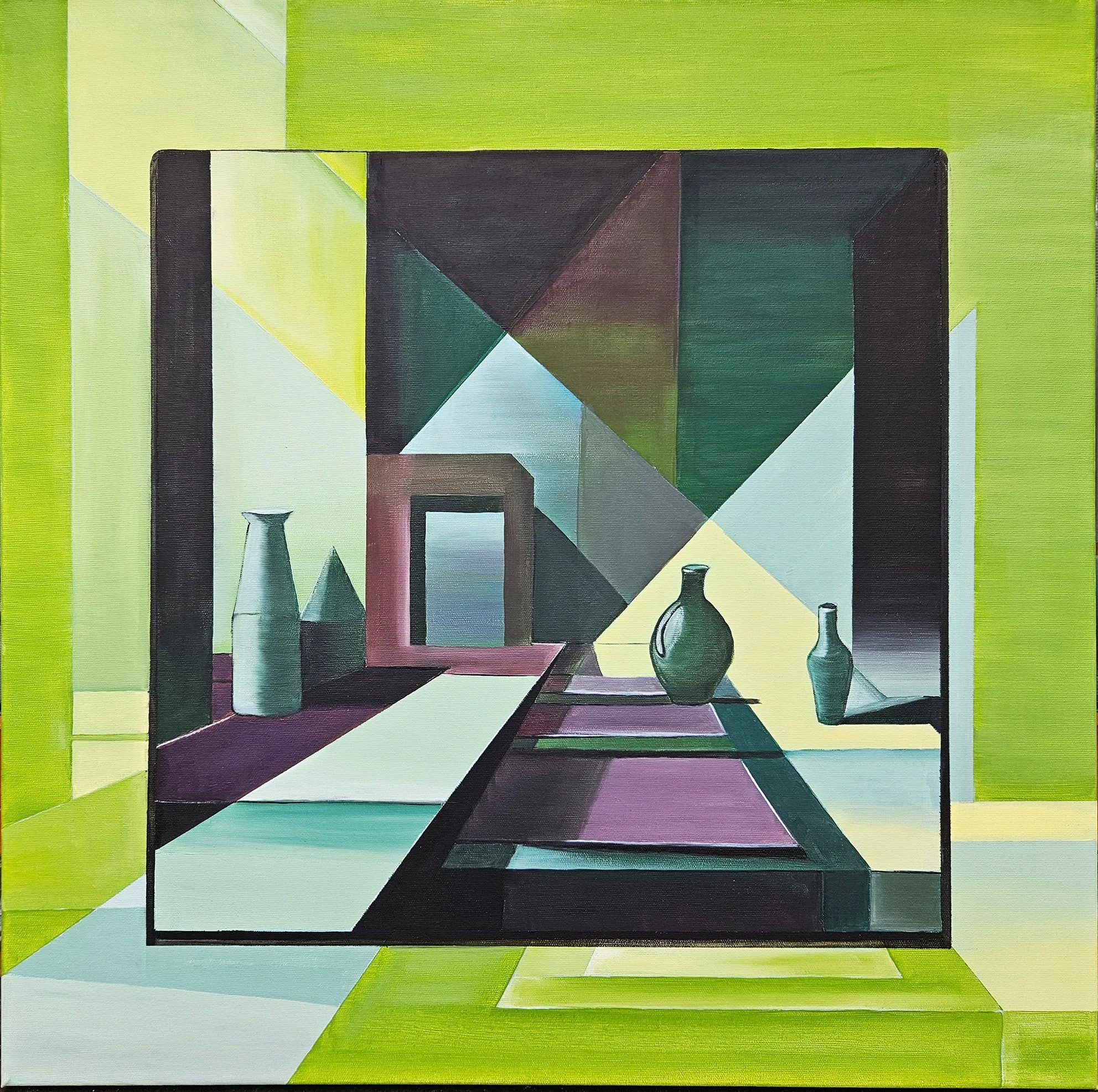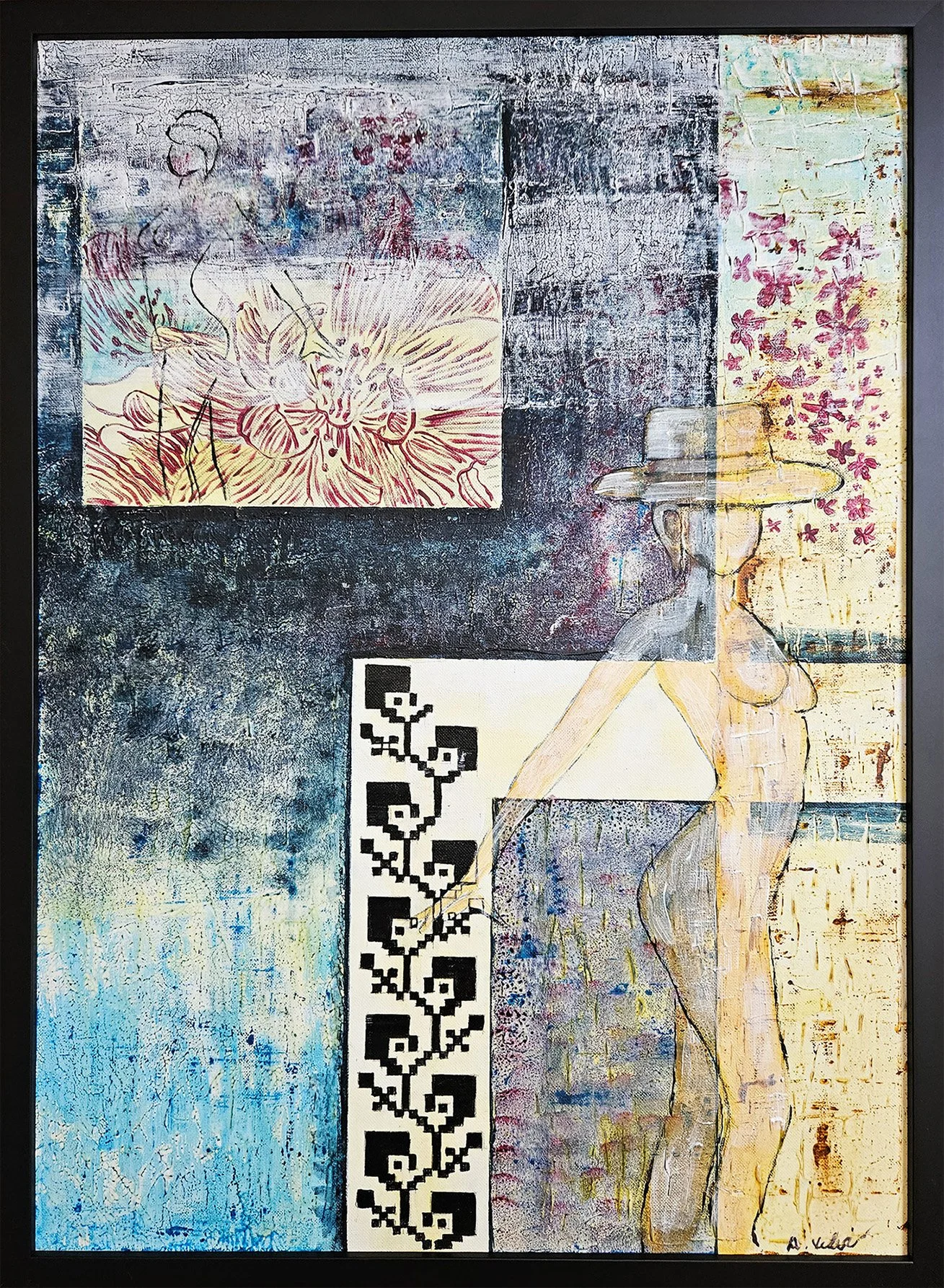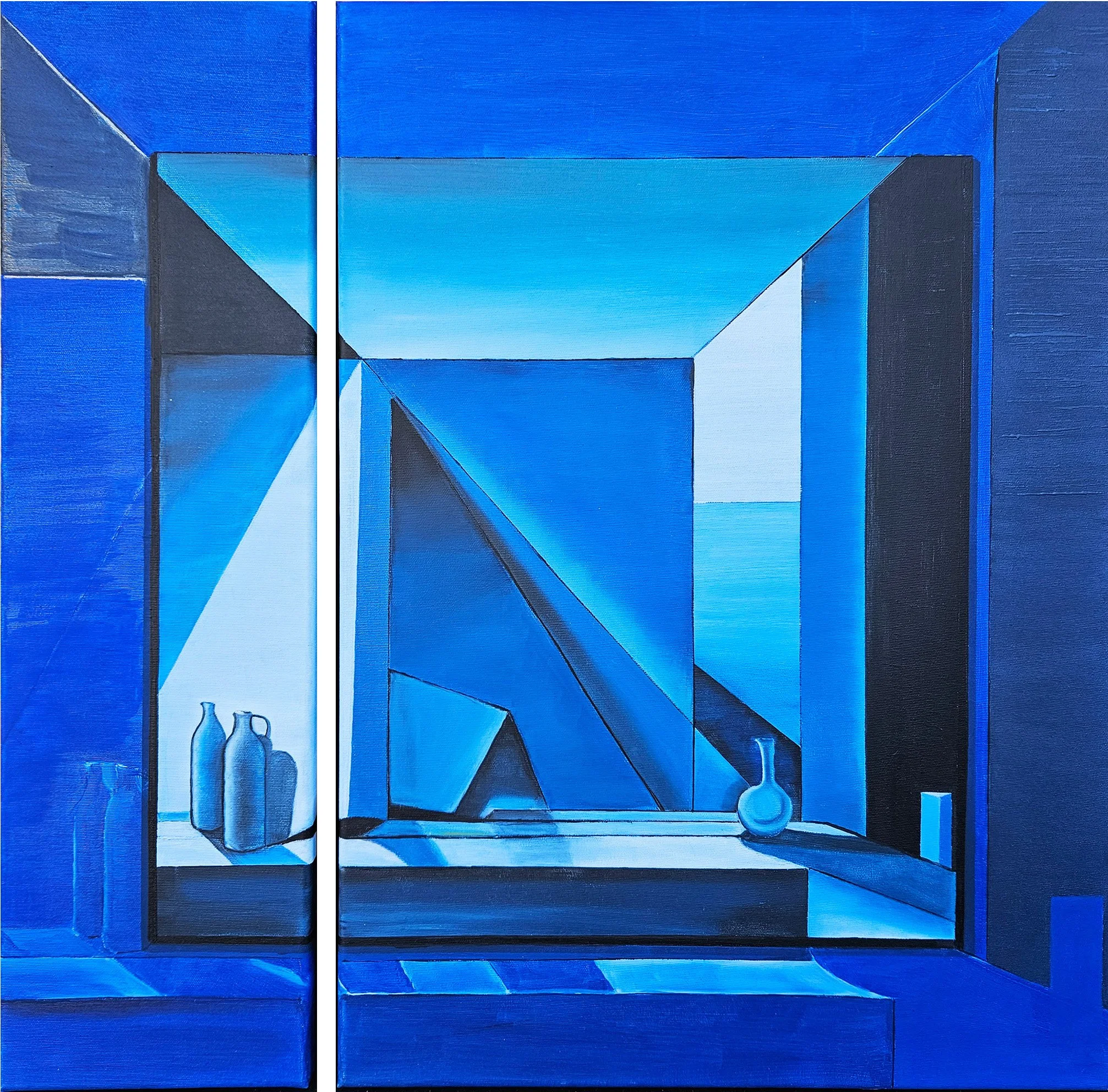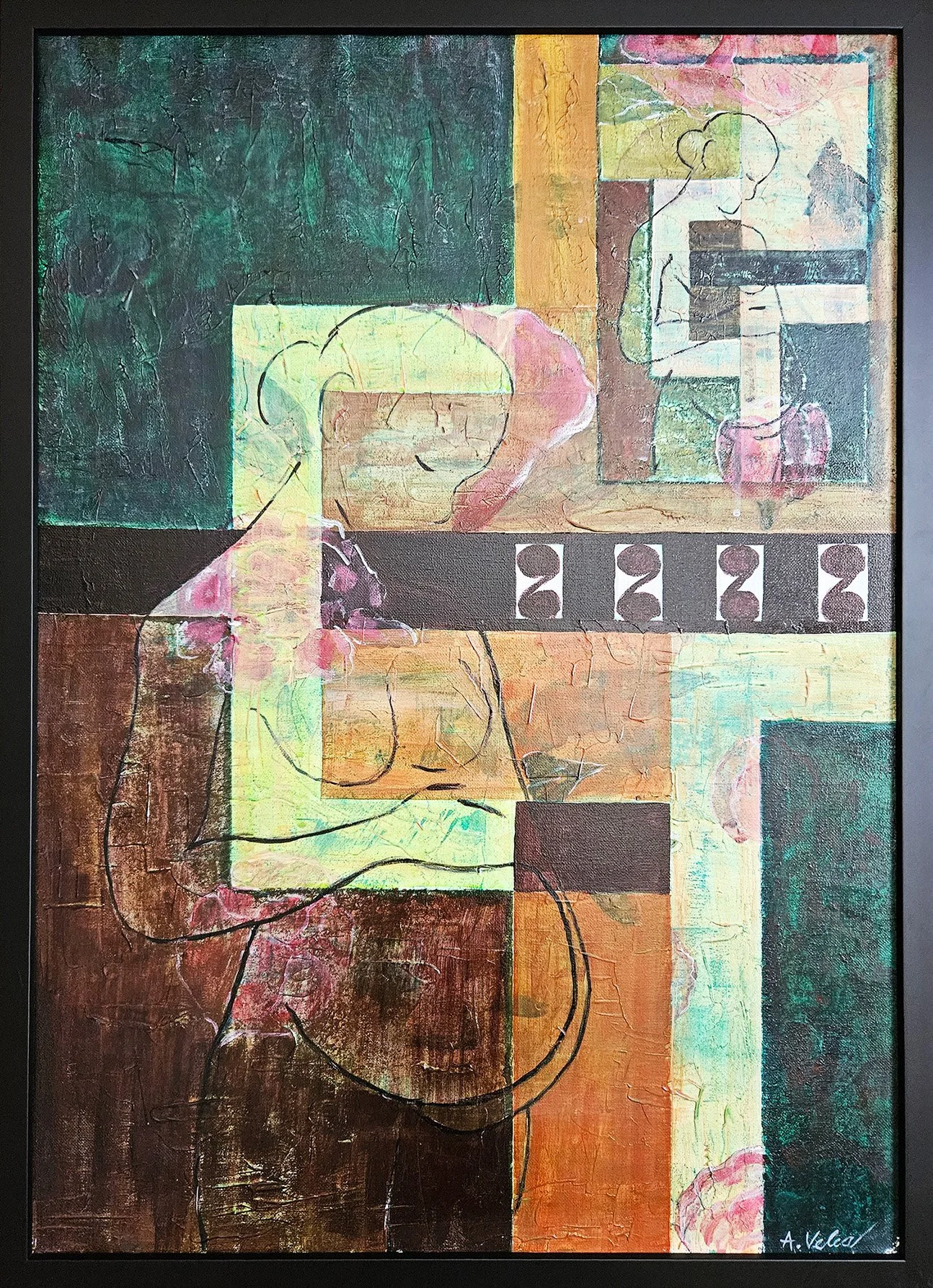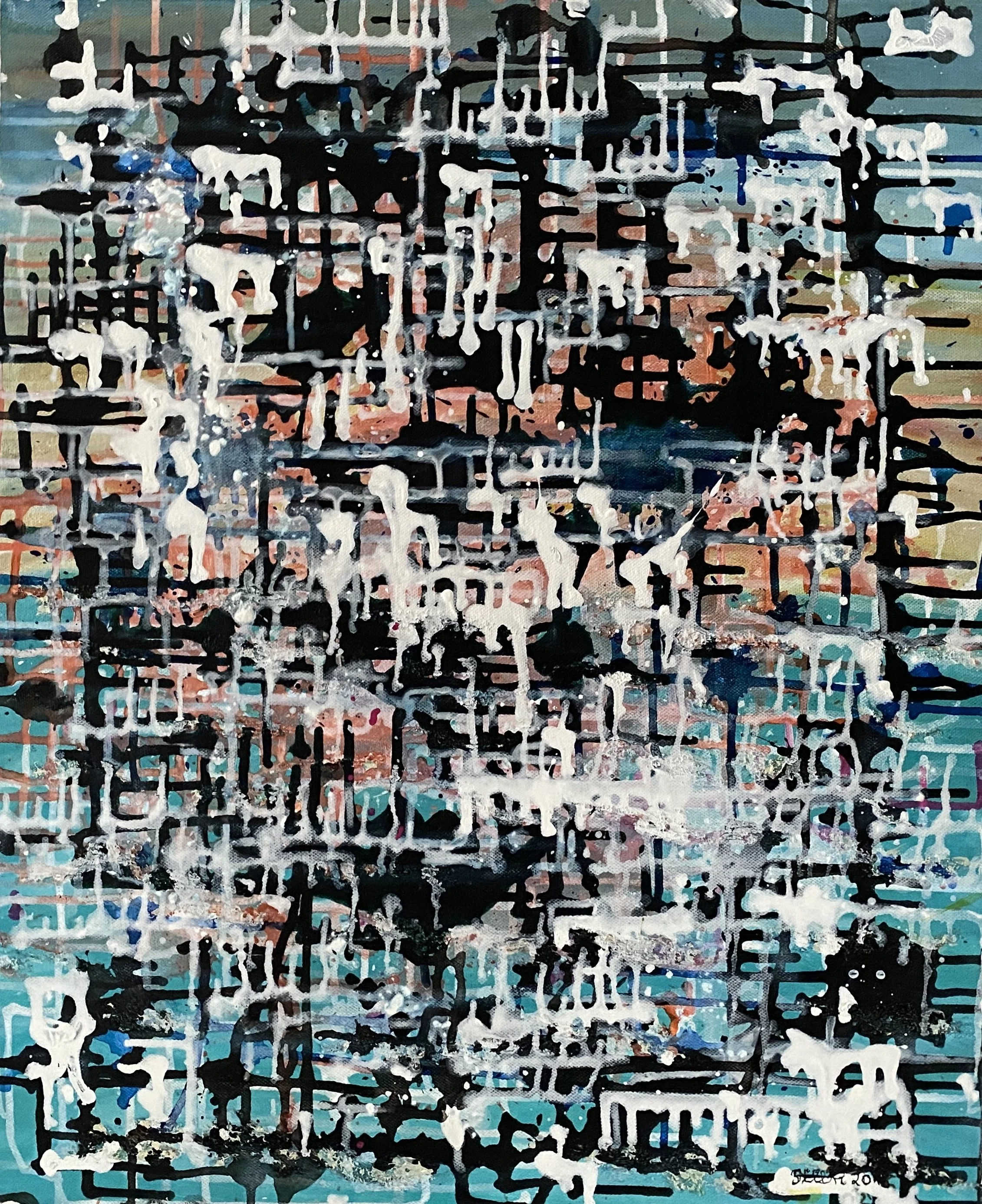Interview with Alida Velea
My values represent the landmarks according to which I approach a subject that I want to present through art. They serve as an inner compass, and my way of expressing them has evolved with my growth in this field.
I am part of a community of artists interested in exploring places, spaces, people, and objects. I try to be involved in presenting events and analyse how they continue to have an impact over us.
Sensitivity to the social environment and respect for the past, for me, entail bringing old models into the present to engage in a silent dialogue with my audience. And, as the viewer reacts, the enthusiasm for the new may call into question the perception of the old, of identity, and of themselves.
You skillfully blend traditional artistic methods with the latest technological advancements in your art. How do you navigate the preservation of traditional art forms while incorporating innovative digital techniques? What are the primary challenges you face in this fusion, and how do you resolve conflicts between traditional authenticity and modern expression?
In achieving the union of traditional artistic methods with recent technological advances, I am driven by intrinsic motivation. On one hand, traditional and classic elements arise naturally from within me, fulfilling a personal need for expression. On the other hand, modern digital techniques are the means I choose to convey this expression.
How do I combine them? I enjoy studying and analyzing traditional art: I visit authentic folk-art fairs, examine the works of contemporary artists who, like me, draw inspiration from and utilize traditional artistic methods and models, and explore the deeper meanings behind craftwork and folk motifs. For example, the designs on Romanian traditional clothing carry specific meanings: the circle symbolizes regeneration and cyclicity, the cross represents balance, and the spiral signifies fertility and evolution.
The real challenge lies in incorporating these elements into the composition of a modern artwork. Depending on the theme I wish to present, I select the appropriate traditional method or motif. I then research and work meticulously until I arrive at a final piece where traditional authenticity and modern expression harmoniously complement each other.
Your artistic narrative often revisits significant historical events. Could you describe the process through which you select these events for your work? What specific criteria do you use to determine which historical narratives warrant re-examination and artistic representation, and how do you ensure that your portrayal resonates with contemporary audiences?
Yes, I occasionally explore historical themes in my work. To provide a clear example, I will reference my most recent project with a historical focus, titled "Romanian Stamp Collection 1967-1985."
This series features nine digital collages, created using relevant photographs from the communist era. These images depict a range of scenes, from people standing in line for basic food necessities to political prisoners who were exterminated in labor camps. The collages are further enhanced by stamps from my personal collection, issued during that period, which glorify communism.
Additionally, the project includes a short film that include the collages and presents the idea of the subtitle: "Archive: Time, History, Memory". The entire project was conceived as a narrative to portray the harsh realities of life under a totalitarian regime for a generation that has not experienced such hardships. It underscores the significance of freedom and everything that comes with it.
The choice to use modern mediums—digital collages and film—rather than traditional ones was intentional, aimed specifically at engaging a younger audience. At the request of an art gallery in Piacenza, Italy, I will present the entire project in a solo exhibition this October. This opportunity reaffirms that contemporary audiences resonate with and are eager to learn more about the past.
You have described your commitment to a figurative style as an intrinsic part of your national identity. In what ways do you believe your artwork contributes to or challenges the traditional perceptions of your country's cultural and artistic heritage? How do you handle the responsibility of representing such identity in your work?
I do believe that the figurative-geometric style I have chosen is deeply rooted in my national identity; many of the most renowned Romanian artists embraced a classical, figurative style. The geometric aspect of my work is influenced by the avant-garde cubism of Constantin Brancusi, a Romanian artist who drew inspiration from traditional Romanian art and whom I consider one of the greatest visual artists of all time.
My work seeks to convey a message about the importance of preserving authenticity and the unique culture that defines each nation. Romanian traditional culture is the one I know best and have studied extensively, so it naturally features prominently in my work. By incorporating traditional elements into contemporary art and addressing a wide range of themes, from social to emotional, I aim to fulfill the responsibility you mentioned.
Given your proximity to the National Botanical Garden, how do elements of nature influence your artworks, particularly those focused on cultural identity and historical themes? Could you share an example of how a specific natural element or scene has directly inspired one of your pieces?
With a rich history dating back to 1860, the "Dimitrie Brândză" Botanical Garden is a place where I find solace and clarity, allowing me to organize my thoughts. In the midst of Bucharest—a bustling, cosmopolitan city—the garden serves as my personal oasis.
In one of my online collective exhibition projects, the botanical garden and its history served as my primary sources of inspiration. The resulting film, which was featured in the exhibition, is named after the garden’s founder, Brândză.
Another example of nature's influence, drawn from this same natural setting, is my "Feminine Frames" series. This series blends vibrant colors and floral elements with traditional Romanian motifs. As the series presents key stages in a woman's life, the background colors shift to reflect the changing seasons. For instance, the piece "Tenderness" is composed with a palette of mature green and orange, echoing the hues of spring. This color combination symbolizes the season of pregnancy, where, much like nature, a woman experiences the joy of creation.
What specific role do digital tools play within your creative process? How do these tools enable you to achieve effects or convey messages that might be challenging or impossible with traditional techniques alone?
I enjoy working with digital tools complemented by a traditional medium that requires hands-on effort. For instance, a digital collage might be based on a physical collage or painting, as seen in my "Toxicity" series. Alternatively, I might start with a digitally created design, then translate it into a sketch, which I later transfer onto canvas to develop into a painting, as I did in the "Unfolding the Rainbow" series.
In my view, relying solely on one technique—whether digital or traditional—would be simpler and easier, but it would also be less effective in conveying emotions. The combination of these two mediums, one classic and one modern, allows me to create unique, authentic works that provoke thought in the viewers. This approach encourages them to ask questions such as, "Why did she construct it in this way and not in another?" or "What is the significance of that symbol?".
Considering the rich cultural and historical elements woven into your art, what do you aim for viewers to derive from your pieces? How do you assess their responses, and have any interpretations of your artwork been particularly unexpected or fascinating to you?
Each series of my works—whether drawing, painting, film, or collage—is crafted to convey a specific message. The historical pieces, for instance, draw parallels between the past and present, serving as a reminder of the importance of learning from history to avoid repeating its mistakes.
"Feminine Frames," as I mentioned in the artist's statement accompanying the series, is intended to provoke debate: is the message pro-feminism, or is it not? My artist statements often include questions for the viewers, which is my way of engaging with them and encouraging deeper reflection.
As for whether any of my works have been interpreted in unexpected ways, the answer is "Yes!" One such instance involves the piece "Harmony" from the "Feminine Frames" series. I once discussed this series with a gallerist who described the work in a way that profoundly surprised and delighted me. She said, "I love the joy and effervescence that the piece exudes... the sensuality of the silhouette, mixed with a kind of innocence, suggested by certain lines that evoke the body of a child... It is anchored in tradition and the present reality, hinted at by the Romanian blouse pattern in the background, which seems to draw a boundary. And the chosen color of the model, the black in the center of the image, draws the viewer's gaze, pulling them in... The young woman’s hand rests on it, even though her body is oriented elsewhere, suggesting other desires and needs."
Her interpretation went far beyond what I had originally intended, both in terms of meaning and message. It was an interpretation that was both surprising and immensely gratifying.
You have mentioned that your creative process involves translating mental images, related to both events and feelings, into various visual forms. Could you elaborate on how you develop these concepts from initial thoughts or emotions into fully realized artworks? What challenges do you face in this translation process?
Yes, this is generally how I create my works!
An important event, something I experience, or even something I observe—whether beautiful or ugly—triggers a strong emotion within me. What is interesting is that, most of the time, my mind immediately associates this emotion with a specific image. Whether it is day or night, I try to quickly capture this image in a rough sketch. I manage to retain some details in my mind, and even if I cannot fully identify or name them at that moment, I attempt to sketch them out. I always revisit these initial notes and drawings.
The challenge lies in the extensive research process I often undertake before starting a series. I do not always have the answers to the questions I ask myself, so I delve deeply into research, gathering information on what I want to convey: What is the message of the works? What questions should the viewer be able to answer, and which ones should remain open? Should the works be simpler, or do they need additional elements, like a symbol?
This process is long and complex, requiring a great deal of energy and time, but I love every part of it!
How do you decide which artistic medium is most appropriate for expressing a particular concept? Are there instances where you have begun a project using one medium and found through your creative evolution that another medium better suits the message or theme?
I really love to paint! I believe that painting is the most sought-after medium for a visual artist who is skilled in multiple forms of expression.
The medium I choose for a particular series depends on both the message I want to convey and the audience I want to reach. For younger generations, I often use modern mediums, like digital techniques, because I think they connect better with a message delivered in this way—it is more interactive and contemporary. However, if the subject is a classic one, with older debates, or involves something like the representation of still life, I tend to opt for a traditional medium, such as painting.
There have been times when I have changed the medium during the creative process. My current series, "Catharsis", which is still in progress, is a good example. It started as a photograph, evolved into a digital collage, and is now being realized as an oil painting on canvas. I usually do not discuss works in progress, so for now, I will leave it at that.
Your works are seen as modern vessels for carrying forward elements of cultural importance. What aspects of your culture do you find most critical to preserve through your art, and how do you select these elements? How does your art contribute to broader cultural preservation efforts?
I believe that everything related to national identity must be preserved. As I mentioned earlier, folk art and crafts, which are now on the brink of extinction worldwide, are vital elements of the cultural heritage. Romania boasts landscapes of an almost mystical beauty—scenes of unique and timeless charm - UNESCO sites. While I wish we could preserve them forever, if that is not possible, then my duty, as an artist, is to capture their essence. And I am striving to do just that! I have a rich collection of photos and sketches, inspired by the cultural and natural heritage, that I have used so far and that I hope to enrich for my future works.
As a contemporary artist, how can I contribute to cultural preservation? This is a big question! I strive to infuse in part of my creations, an element of authenticity: a symbol drawn from folklore, from craft work, a relevant element of a landscape, a specific color ...
Whether I succeed in this mission will ultimately be for future generations to judge.
As technological advancements continue to redefine the landscape of artistic expression, how do you foresee the future of traditional art forms? Do you believe that digital and traditional art practices will increasingly converge, or is there a risk that traditional methods might become overshadowed or even obsolete in the face of digital innovation?
Artistic expression, as you mentioned, is constantly evolving due to both technological advancements and the increasing demands of audiences. Fine art has undergone numerous movements over time, and none can be deemed outdated.
Today, the greatest challenge for a visual artist is to create a work that conveys a powerful message while also being suitable for display in a gallery or, perhaps, in a room or an office.
In my view, we are currently in a transitional phase where traditional practices are being integrated with digital techniques. AI can already produce images that are difficult to replicate with a pencil or a brush. However, the discerning public—those for whom an artist truly creates—will always seek, and know how to appreciate, the rhythm of the brush strokes, the texture of paint layers, and whether spatial depth is achieved through color or material. They desire, beyond the canvas or any other medium, to experience the emotion of the artist.
I believe that, despite its precision, digital art will never fully capture or convey such depth of feeling.
https://alidavelea.com/





